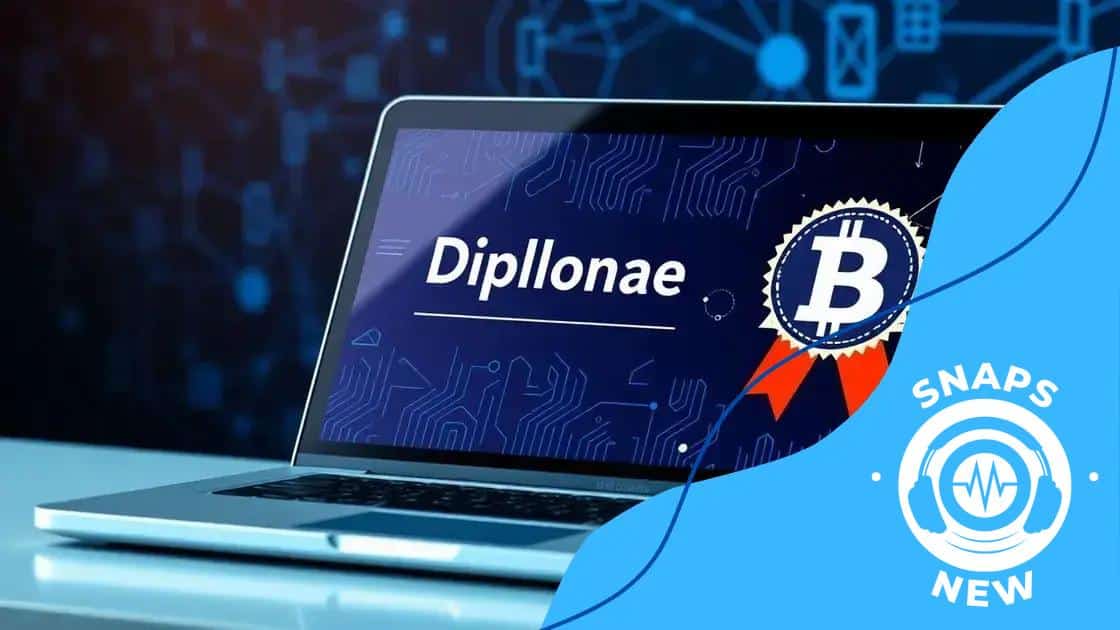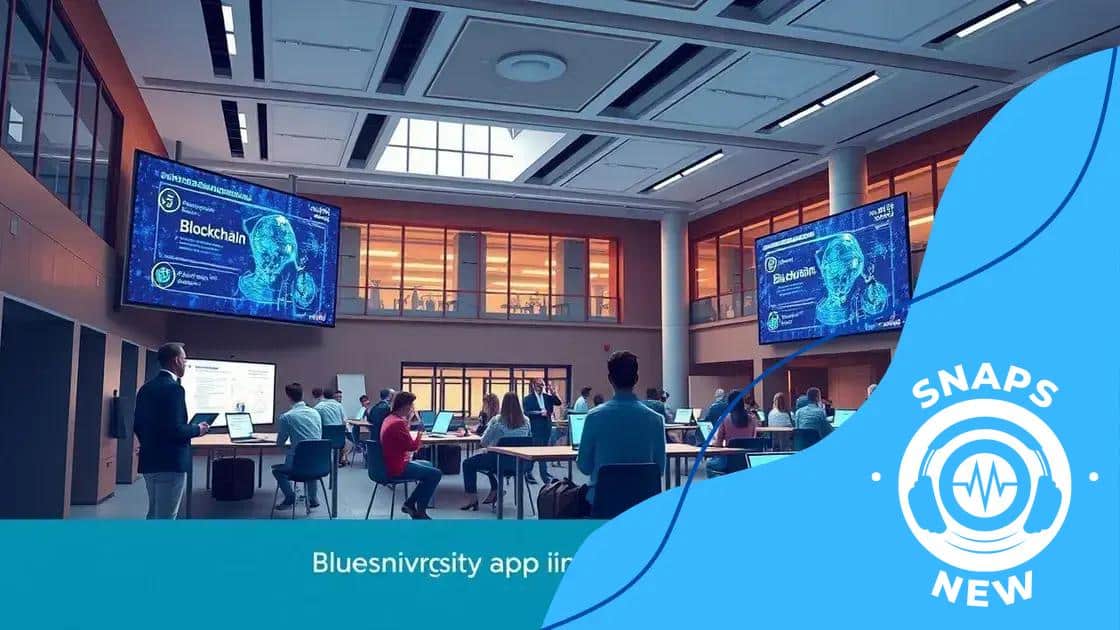Blockchain for academic credentials: revolutionizing education

Blockchain for academic credentials enhances security, streamlines verification processes, and supports the growing trend of micro-credentials, transforming how educational qualifications are recognized and utilized globally.
Blockchain for academic credentials is emerging as a game-changer in the education sector. Have you ever wondered how this technology could enhance the way we verify qualifications? Let’s dive into its potential.
Understanding blockchain technology
To grasp the essence of blockchain technology, it helps to know how it works. It’s a decentralized system that stores data across a network, ensuring transparency and security. Each transaction is saved in a “block,” which is then linked to previous blocks, forming a “chain.” This structure makes it nearly impossible to alter any information without raising alerts throughout the network.
The Key Features of Blockchain
One of the most enticing aspects of blockchain is its unique characteristics:
- Decentralization: No central authority controls it, reducing risks of fraud.
- Transparency: All transactions are visible to participants, promoting trust.
- Security: Cryptography secures data, making hacking extremely difficult.
- Immutability: Once data is recorded, it’s almost impossible to change.
The applications of blockchain extend beyond cryptocurrencies. It’s already being used in various fields like finance, supply chain management, and healthcare. For example, in the medical sector, it can securely store patient records while giving patients control over their own data.
By utilizing smart contracts, actions can be automated based on predefined conditions. This kind of innovation enhances efficiency and reduces the need for intermediaries. Furthermore, as more organizations realize the potential of blockchain, we can expect new uses to emerge, reshaping many industries.
Understanding how blockchain technology operates is crucial for knowing its potential impact. Many see it as a tool for ensuring integrity in record-keeping, leading us toward a more trustworthy digital world. As technology evolves, its integration into everyday applications will likely become more prevalent, changing how we interact with data and each other.
Benefits of blockchain for credential verification
The benefits of blockchain for credential verification are becoming increasingly clear. By utilizing this innovative technology, institutions can offer a more secure and reliable way to confirm qualifications. Traditional methods often involve manual checks, which are time-consuming and prone to error. In contrast, blockchain allows for seamless verification.
Enhanced Security
One key advantage of blockchain technology is its enhanced security features. Each record on the blockchain is encrypted, ensuring that sensitive personal information remains protected. This makes it extremely difficult for fraudsters to tamper with records, thus maintaining the integrity of educational credentials.
Instant Verification
Blockchain enables institutions to provide instant verification of credentials. Employers and other organizations can easily access and confirm qualifications without lengthy waiting periods. This speed not only saves time but also enhances the hiring process.
- Reduced Costs: Automating verification processes cuts down administrative costs for institutions.
- Increased Trust: Stakeholders have more confidence when they know a reliable system backs the credentials.
- Decentralized Management: Institutions don’t have to rely on a central authority, which minimizes risks of data loss.
Additionally, using blockchain supports the idea of lifelong learning. As individuals add more qualifications over time, these can be securely stored and easily shared. This is beneficial not only for job seekers but also for employers looking for candidates with diverse skills.
As adoption of blockchain for credential verification grows, we can expect to see a shift in how educational systems operate. Institutions that embrace this technology are likely to stay ahead of the curve, improving their reputations and attracting more students.
How universities are adopting blockchain

Many universities are starting to embrace blockchain technology in various ways. By integrating this innovative system, educational institutions can enhance their processes and improve the student experience. This shift is not only about keeping up with technology but also about paving the way for more secure and efficient operations.
Incorporating Blockchain into Administrative Processes
Universities are using blockchain to streamline administrative tasks. For example, they can manage student records and transcripts more efficiently. Traditionally, checking these documents involved time-consuming processes, but with blockchain, verification becomes instantaneous. This not only saves time for the university staff but also enhances the student experience.
Global Recognition and Transfer of Credits
Another way institutions are adopting blockchain technology is through global credential recognition. Students studying abroad can have their credits transferred seamlessly between institutions without the usual red tape. This global perspective attracts more international students and supports mobility in education.
- Collaborations: Universities are partnering with tech companies to develop blockchain applications tailored for education.
- Online Courses: With the rise of online education, blockchain helps verify the credentials earned through various digital portals.
- Research Integrity: Some universities use blockchain to ensure transparency in research, safeguarding studies from manipulation.
Moreover, workshops and training sessions on blockchain technology are being organized for students and faculty. This initiative ensures that everyone is equipped with the necessary skills and knowledge to navigate the evolving landscape of higher education.
As more universities adopt this technology, we can expect to see significant changes in how education is delivered and verified. Institutions that embrace blockchain not only enhance their operational efficiency but also prepare students for the future workforce, making them more competitive in a global market.
Challenges in implementing blockchain solutions
Implementing blockchain solutions comes with several challenges that must be addressed for successful integration. Understanding these hurdles can help organizations prepare better and create effective strategies for embracing this technology.
Technical Barriers
One major challenge is the technical complexity of blockchain systems. Developing, maintaining, and updating blockchain technology requires specialized knowledge. Organizations often struggle to find skilled professionals who understand the intricacies of blockchain.
Regulatory Concerns
Another significant hurdle is the regulatory landscape surrounding blockchain technology. Different regions have varying laws regarding data privacy and security. Organizations must navigate these regulations carefully to avoid legal issues.
- Compliance: Ensuring compliance with local laws is crucial for any blockchain solution.
- Data Sovereignty: Concerns about where data is stored and who has access can complicate implementation.
- Changing Regulations: The rapid evolution of laws can create uncertainty in planning.
Moreover, the integration of blockchain with existing systems can be challenging. Many organizations have legacy systems that may not easily connect with the new technology. Transitioning to blockchain often involves significant downtime and resource allocation.
Cost is another factor to consider. Implementing a blockchain solution can be expensive, involving hardware, software, and the costs associated with training staff. Organizations need to weigh the long-term benefits against the initial investment carefully.
Finally, there’s the challenge of user acceptance. Many stakeholders may be hesitant to adopt new technology, preferring the familiarity of existing processes. Ensuring that everyone is on board with blockchain solutions is essential for success.
Future trends in educational credentials
The future of educational credentials is exciting, with technology leading the way. As institutions continue to adopt blockchain technology, we will see significant changes in how qualifications are verified and recognized. This evolution aims to make the process faster, more reliable, and globally accessible.
Micro-Credentials and Badges
One of the emerging trends is the rise of micro-credentials. These are short, focused qualifications that allow learners to demonstrate specific skills or competencies. As employers seek versatile candidates, micro-credentials will gain popularity. They provide an efficient way for individuals to showcase their abilities outside traditional degrees.
Personal Learning Environments
Another trend is the shift toward personal learning environments. With advancements in technology, learners can customize their educational journeys. This includes choosing courses that align with their career goals. As a result, educational credentials will evolve to reflect a more personalized learning experience.
- Blockchain Records: Credentials will often be stored on blockchain platforms, enhancing security and accessibility.
- Global Compatibility: Recognizing credentials across borders will become smoother, facilitating international education.
- Focus on Lifelong Learning: Credentials will increasingly reflect ongoing education and skill development throughout a person’s life.
Additionally, organizations are starting to value skills over degrees. This shift means that future credentials may focus more on proven abilities rather than traditional educational routes. As the job market evolves, so too will the types of qualifications that are recognized.
Social and environmental considerations are also influencing future trends. More companies are looking for candidates who demonstrate a commitment to sustainability and ethical practices. Educational programs may begin to incorporate these elements into their curricula, leading to new types of credentials.
In conclusion, the potential of blockchain technology in education is vast and still unfolding. As universities and institutions adapt, we can expect more secure and streamlined methods for verifying educational credentials. Trends like micro-credentials and personalized learning are shaping the future, making it essential for students and educators to stay informed. Embracing these changes can lead to a more inclusive and efficient educational system, benefiting everyone in the long run. As we look ahead, the integration of technology in education will continue to redefine how we learn and validate knowledge.
FAQ – Frequently Asked Questions about Blockchain for Educational Credentials
What is blockchain technology in education?
Blockchain technology in education is a decentralized system that securely stores and verifies educational credentials.
How can micro-credentials benefit students?
Micro-credentials allow students to showcase specific skills and competencies, making them more attractive to employers.
Why should universities adopt blockchain solutions?
Universities should adopt blockchain solutions to enhance security, improve verification speed, and facilitate global recognition of credentials.
What challenges are associated with implementing blockchain in education?
Challenges include technical complexities, regulatory concerns, high costs, and the need for user acceptance of new systems.





